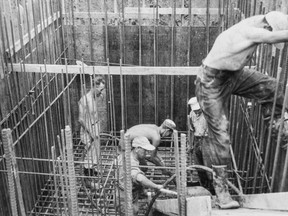
A feature documentary currently under development aims to tell the story of one of Ontario’s worst workplace tragedies, while memorializing the immigrant workers who lost their lives nearly 70 years ago.
Advertisement 2
Article content
Dresden 1957 explores the disaster that occurred during the construction of a pumping station in the North Kent community.
Article content
On Aug. 14 of that year, two weeks after starting the project, one side of the 35-foot pit collapsed and six workers, all Dutch immigrants, were buried alive.
Despite concerns raised beforehand with the site, their deaths were ruled accidental and the contractor was acquitted in a trial.
“When it happened it was covered massively,” said Eric Philpott, a Toronto-based writer and director. “It was news across the country. I even found television footage.”
However, even with nationwide coverage, the story seemed to disappear as the years passed, he said, noting there is very little about it online.
Advertisement 3
Article content
The story also has a personal touch for Philpott.
In 1957, Eric’s father, Keith Philpott, was the site engineer for the construction of the pumping station. He was only 25 and recently arrived from Britain.
Keith had a number of safety concerns, but the contractor didn’t listen.
With his father’s diary, letters and photos providing a narrative, Philpott hopes to shed more light on the tragedy.
“He saved all this material,” he said. “It’s really like a time capsule.”
The six men who died had arrived in Canada with their families between 1951 and 1953. The youngest was Wilfred Hovius, 19, who died with his father Enne, 39. The oldest, Henrik Drenth, was 58. Jan Bremer was 43 and Jan Oldewening was 45. Their foreman, Dirk Ryksen, was 36.
Advertisement 4
Article content
Between them, they left five widows and 20 children.
Dresden was one of the first communities to receive funding from the recently formed Ontario Water Resources Commission to build a new water treatment plant.
The workers who died had settled in the Aylmer area, and their foreman lived in Byron, now part of London. Keillor Construction, who won the contract to build the water plant, was based in St. Thomas.
The plant and pumping station were designed by Canadian British Consulting Engineers, in Toronto, who sent a junior engineer, Philpott’s father, to Dresden to ensure construction was completed according to their specifications.

Philpott said his father noticed red flags at the site, such as the steepness and soil instability. He then raised the issue with his superiors and the contractor.
Advertisement 5
Article content
“They had cave-ins before this happened, the week before,” he said. “They widened the top of the pit, but not the bottom.
“What they should have done was get a soil test, which would’ve told them… this is really dangerous. You probably shouldn’t even dig here.”
In the aftermath, Philpott said many who were deeply affected simply didn’t talk much about it.
“In those days, that’s how you dealt with bad things,” he said. “To be fair to Dresden, the town was traumatized by this. This was a horrific experience.
“Hundreds of people were there and many dozens of citizens were in there digging, trying to save them.”
As for his father, Philpott said, “he told my mother … (but) he never told me about it.”
Other topics in the documentary include life in Ontario in the 1950s, the wave of Dutch migration to Canada, and the challenges newcomers often faced.
Advertisement 6
Article content

Philpott has worked in film and broadcasting since 2002, including 10 years as a product marketing manager on the Adobe video team. Prior to this, he taught history in Germany, the US and Canada.
His collaborator on the Dresden project is Joseph Crawford, a Canadian-New Zealand editor with extensive production experience.
In addition to raising awareness about the tragedy, Philpott hopes it underlines to importance ensuring safe workplaces, adding that immigrant workers are particularly vulnerable.
Admitting the fundraising climate for films is challenging, his goal is to complete the documentary this year, so it’s available for viewing next year.
Given the age of many relatives of the victims, he feels a “sense of urgency” with the project.
“I haven’t received one hundred yet of funding for this film,” he said. “But even if I get nothing, I will make this film, because of the families.
“It’s like two tragedies. There’s the tragedy of what happened to the families, and then there’s a second one — no one acknowledges it.”
For more information on the documentary, visit www.dresden1957.com
Article content
